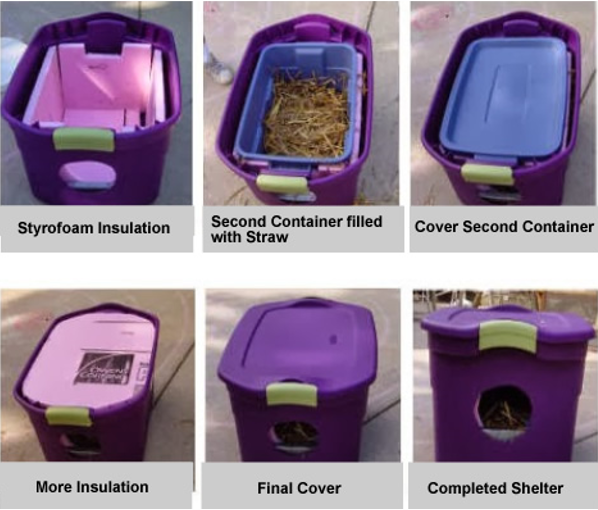Tips On Building a Feral Cat Shelter This Winter

The Humane Society of the United States estimates that there are tens of millions of feral cats in United States. Thanks to their efficient survival skills of scavenging and hunting, outdoor cats are often well suited to survival in a variety of climates, locations, and conditions. But that doesn’t mean they don’t need our help. When it comes to winter, things get much more difficult for these cats.
Here are a few things you can do to help the feral cats in your community, whether you're helping TNR a cat colony, or helping out the cats in your neighborhood that you've been feeding.

Sure, cats have their thick, fluffy coats to help keep warm – but they need shelter to keep them dry and warm and out of the elements. Providing community cats with shelters during the winter is a great way to help them escape the snow and wind chill.
Constructing your own shelter can be relatively easy, and animal rescue organizations have provided plenty of options for building inexpensive cat shelters.
Here is a simple example from Alley Cat Allies!

When it comes to building your own cat shelter, they don’t need to be overly big or complicated. It can be as simple as an insulated cardboard box or even a plastic storage bin!
-
Consider Size. In bigger cat shelters, heat disperses more quickly. The ideal size is about two feet by three feet, at least big enough to accommodate roughly three to five cats.
The smaller the shelter and the closer the cats, the easier it is for the box to stay warm.
The entrance to the shelter should only be big enough for cats; putting a flap over the doorway can also help to keep out predators, and the elements (wind, rain, snow).
-
Insulation. It’s also important to use proper insulation materials to help trap as much heat as possible. In climates with extreme cold, it might be necessary to line the shelters with Mylar blankets. But generally, less expensive insulation materials are available. Avoid using blankets, towels, and hay as insulators.
Straw (which is actually different from hay—who knew?) is an ideal insulator, as it is loose, dry, and doesn’t readily absorb and hold moisture.
Blankets, towels, and hay are not ideal as they easily draw in moisture and can freeze, but also grow mildew and mold which can cause illness.
-
Placement. Placement is just as important as the construction materials, because they can only do so much against the elements - and it may help your feral cats go into the shelter more readily.
- Situate the shelter out of the wind and in a spot that gets the most sun exposure, to help keep it out of the elements as much as possible. The sun can also help it warm up, and dry it out.
- Place your shelter against (or under) a structure, whether it's against a house, fence, or porch; under a bush or tree could also work.
- Raised structures are ideal to help keep them out of puddles and avoid water or snow damage. Consider using bricks, or even a pallet to raise the cat shelter - but make sure it is stable and doesn't wobble!
- Most TNR recommend placing two shelters facing each other, about 1.5-2 feet apart. Placing a plank of wood on top of the two cat shelters, or in front of (at a slant) to prevent the elements from getting in, but not blocking the cats.
- Face the entry way of the shelter facing toward a wall, so that only cats can get in and out.
- Avoid high traffic areas (such as people, dogs, other wildlife) as this may cause the cats to avoid the shelter as they may feel threatened.
- If you've been observing the cat (or cats) for a while, try to put the shelter in an area you know they favor, that they might be willing to investigate!
- Place near a feeding station the cats prefer, but not directly next to the food. Cats know that food attracts other animals (that could be potential predators) and instinctively do not often wish to sleep next to food.
- When in doubt, sprinkle with catnip (or silver vine). Both are cat-safe cat attractants that may tempt the kitties inside. And bonus - it won't attract any other animals that food/treats might!
For more in-depth DIY cat shelter ideas, you can check out Alley Cat Allies or Neighborhood Cats for excellent tutorials and suggestions! You can even check YouTube for instructional videos, like the one below.
And a big thank you to everyone who takes it upon themselves to build shelters for these cats in need!

















Leave a comment